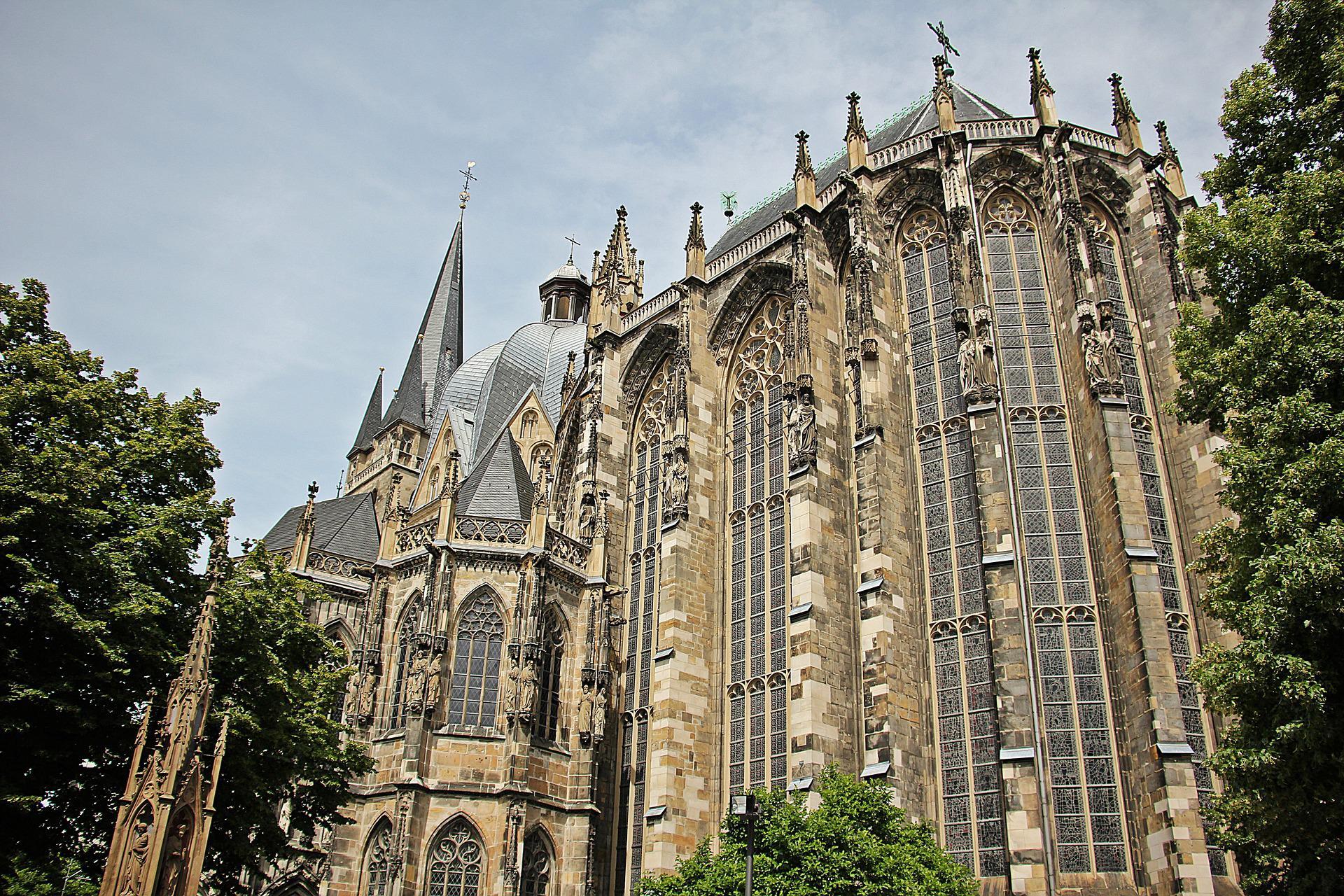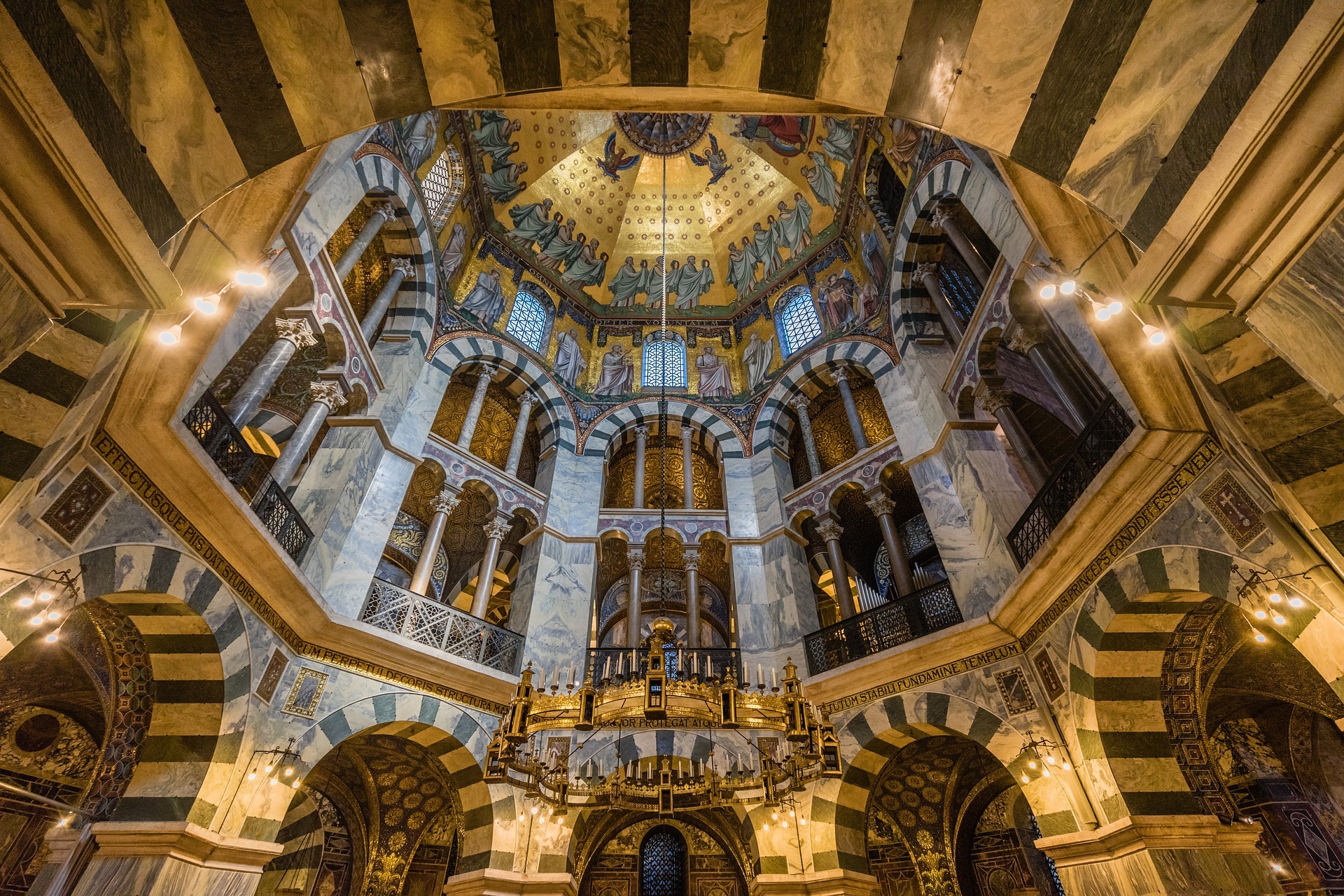
Aachen Cathedral, with its millennia-old pilgrimage, is history made of stone and a living story. One part of this multifaceted building is particularly precious for Hungary. King Louis of Hungary, inspired by his pious, art enthusiast mother, donated a chapel that was added to the original building in 1367 as a Gothic side chapel (Hungarian Chapel). After Elizabeth Piasten made the first pilgrimage to Aachen to the shrines, Hungarian pilgrims also made the journey every seven years. In order to give new impetus to this 700-year-old tradition, Peter Drücker, Vicar of the Cathedral of Aachen is on a one-week promotional tour in Hungary, publicizing the shrine pilgrimage that will take place in June 2023.
This article was originally published on our sister site, Ungarn Heute.
The Aachen Pilgrimage was the third most important pilgrimage in Europe after Rome and Santiago de Compostela. Charlemagne, King of the Frankish Empire, had received Mary’s dress, Jesus’ diapers and loincloth, and the beheading cloth of John the Baptist as a gift from the Patriarch of Jerusalem. The legendary treasure of relics is at the center of the pilgrimage to the shrine, which since then has taken place every seven years and usually occupies a period of ten days in the month of June.
In the 14th century, the veneration of the four great Aachen textile relics already began. The pilgrimages to the shrine, which took place every seven years, were accompanied by structural changes to the church. The small rectangular east choir was demolished and a capella vitrea – a high Gothic choir house for the presentation of the shrines and reliquaries was built, the consecration of which took place on the 600th anniversary of Charlemagne’s death in 1414. At the same time, two chapels were added to the octagon on the south side, the Hungarian Chapel (1367), and directly adjacent to the Gothic choir house, the Matthias Chapel (1379/1420).
Fact
How did a Hungarian chapel end up in a World Heritage cathedral?
From the 14th century, more and more people from Hungary came to Aachen, for whom King Louis the Great had the Gothic predecessor of today’s chapel, built in 1367, almost 650 years ago. The chapel was rebuilt in the Baroque style by Maria Theresa and rededicated 250 years ago this year, in 1767. Joseph II forbade Hungarian pilgrimages to Aachen, and the chapel later became the treasury of the cathedral. After 1956, the place became important again to Hungarians, because Aachen, along with Mariazell, became a meeting place for Hungarians who emigrated to Western Europe, and even Cardinal József Mindszenty made pilgrimages there.
An altar to St. Stephen was consecrated on September 15, 1767, in the Hungarian Chapel in honor of King Stephen I of Hungary. On baroque, curved stipes decorated with the Order of St. Stephen, rises a small altarpiece made of textured, light marble with decorated lateral volutes. The tabernacle is closed by a gilded door with a pelican motif. The feeding pelican is represented here as the symbol of Christ’s sacrificial death.
Behind the chapel, there is a life-size statue of King Stephen. The statue by Imre Varga was unveiled in 1993 in the presence of then Prime Minister József Antall.
The motto for 2023: “Discover Me-” Feast of Faith
Peter Drücker, Vicar of the Cathedral of Aachen, now also conveyed the invitation of the Cathedral Chapter to Hungary’s Cardinal Péter Erdő.
We simply want to celebrate, experience faith together, and witness how we relate to Christ. We want to follow the call and declare our allegiance to Christ by living the faith,”
Drücker formulated the intention of the organizers, who also wrote the song of the pilgrimage. He stressed the importance of a common celebration for the divided German Church.
“During the last pilgrimage to the shrine in 2014, a total of 125,000 pilgrims came to Aachen, and we hope for active participation now as well. That is why we have addressed different target groups, children and young people – the carol singers are traditionally always present – soldiers, bikers, firefighters, politicians, for example. The cathedral chapter and the diocese would like to experiment with other forms of events and make targeted, low-threshold offers. Thus, in addition to the mainly ecclesiastical events in cooperation with the city, the diocese, and the cathedral chapter, comprehensive cultural programs are offered at numerous meeting places around the cathedral.”
Related article
Pentecost Pilgrimage of Csíksomlyó Listed as 'Hungaricum'
The Pentecost Pilgrimage of Csíksomlyó and its site is now listed as ‘Hungaricum,’ according to the Hungarikum Committee’s decision announced on Thursday. The pilgrimage of Csíksomlyó is one of the most significant religious feasts of Hungarians around the world, a sign of national unity. ‘Hungaricum’ is a collective term indicating a value worthy of distinction […]Continue reading
The pilgrimage traditionally begins with the ceremony of opening the shrine of Mary, where the four cloth relics are kept. In Charles’ time, the relics were always closed, but since the 14th-century people wanted to see them. The removal of the relics takes place according to the ancient rite. During the opening ceremony, people sit as quietly as mice in the church. The temple of the shrine of the Virgin Mary is smashed and the number of blows is counted. Last time there were 32. After the temple is broken, the shrine is opened and the relics are removed. Only Mary’s silk-wrapped dress is unfolded and hung on a pole to be shown at Masses over the next few days; the other fabrics remain folded and are tied with silk ribbon. In this way they are shown during the next days at the festive masses, otherwise displayed in showcases in the cathedral, in front of which long queues form.
Did Mary wear the dress? Surprisingly, the authenticity of the relics does not play a significant role today. In the 70s, it was a big issue – the cathedral vicar remembers. Today, the relics have significance as a sign of the Incarnation, the poverty of Jesus, and the faithfulness of John the Baptist.

Photo via Pixabay
The final act of the pilgrimage is the closing of the shrine. The relics wrapped in silk are put back, the lock that was broken when the shrine was opened at the beginning of the pilgrimage is replaced with a new one, the shrine is sealed, and the ornamental lock is filled with lead and the key is cut. The cathedral chapter receives the head, the city the beard. This symbolizes the interaction of the church and the city.
Traditionally, numerous church dignitaries attend the festivities. The main celebrant of the festive Mass on Saturday is always the President of the German Bishops’ Conference- on the first Sunday the Apostolic Nuncio of Germany, and on the last Sunday the Cardinal of Cologne. On the days in between, a Hungarian and a Colombian – Bogota is a twin city of Aachen – are always invited. In 2023, pilgrims will celebrate on June 13 with Cardinal Erdő, Primate of Hungary.

Photo via Pixabay
The ten days offer a wide range of events of diverse interests, with extensive social programs, evening events, concerts, and regular tables for pilgrims.
Featured image via Pixabay



